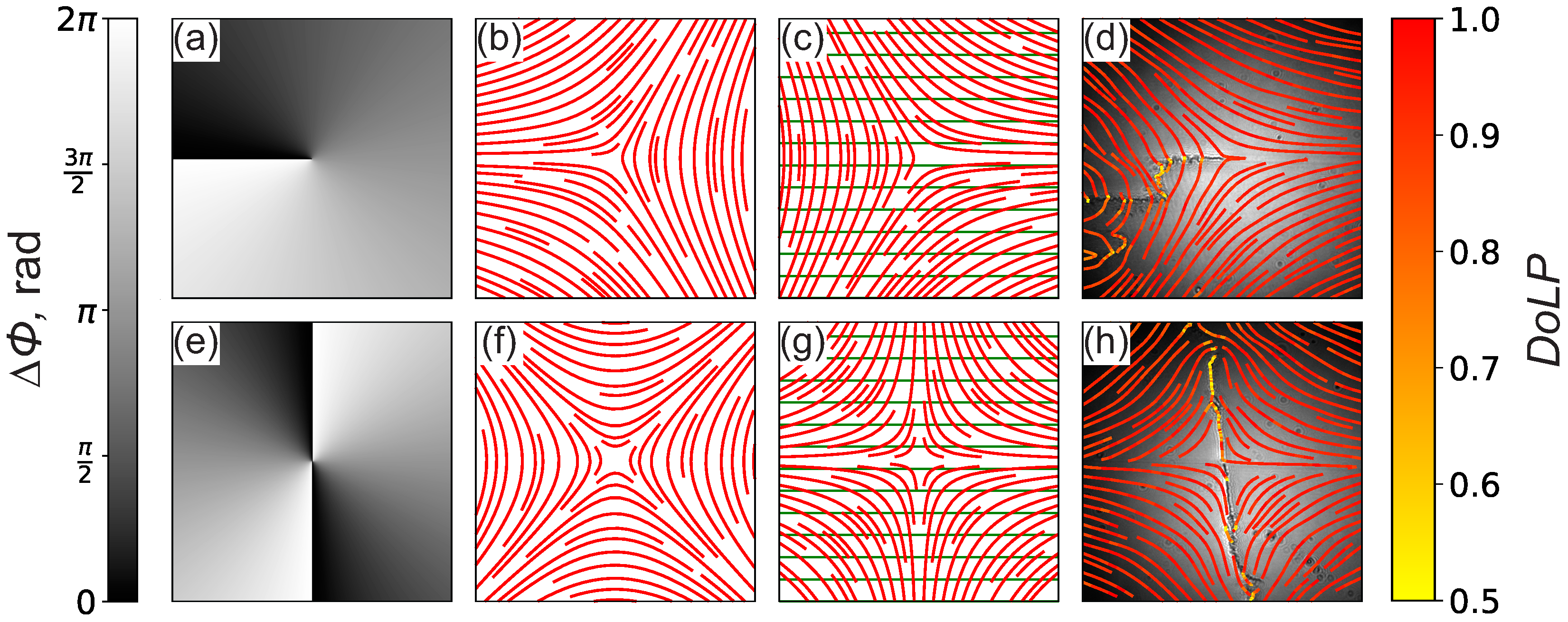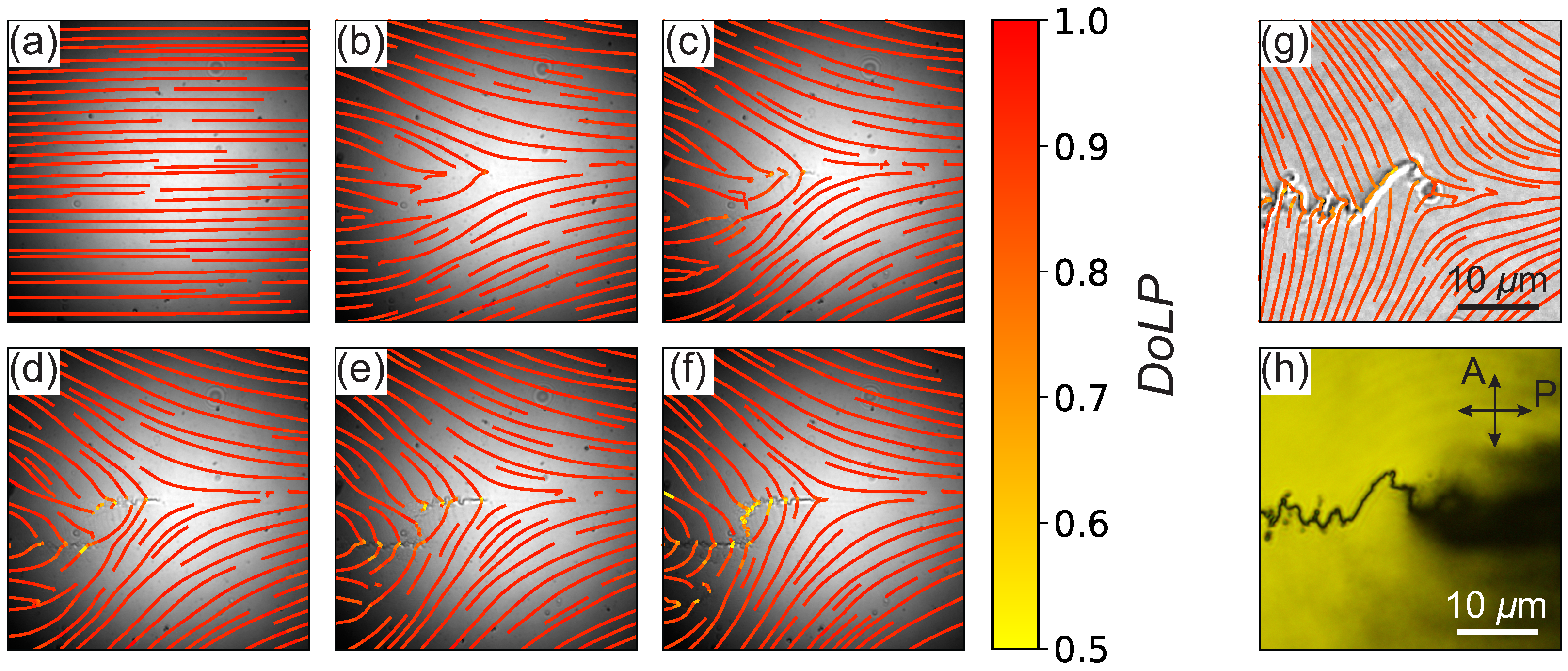On-Demand Photopatterned Twisted Nematics for Generation of Polychromatic Vector Fields
Abstract
1. Introduction
2. Materials and Methods
3. Results and Discussions
4. Conclusions
Author Contributions
Funding
Data Availability Statement
Conflicts of Interest
References
- Kobayashi, S.; Miyama, T.; Akiyama, H.; Ikemura, A.; Kitamura, M. Development of liquid crystal displays and related improvements to their performances. Proc. Jpn. Acad. Ser. B 2022, 98, 493–516. [Google Scholar] [CrossRef]
- Bégel, L.; Khodadad, B.; Galstian, T. Adaptive lens for foveal vision, imaging, and projection over large clear apertures. Opt. Express 2023, 31, 2877–2891. [Google Scholar] [CrossRef]
- Tabiryan, N.V.; Roberts, D.E.; Liao, Z.; Hwang, J.; Moran, M.; Ouskova, O.; Pshenichnyi, A.; Sigley, J.; Tabirian, A.; Vergara, R.; et al. Advances in Transparent Planar Optics: Enabling Large Aperture, Ultrathin Lenses. Adv. Opt. Mater. 2021, 9, 2001692. [Google Scholar] [CrossRef]
- Yang, Y.; Forbes, A.; Cao, L. A review of liquid crystal spatial light modulators: Devices and applications. Opto-Electron. Sci. 2023, 2, 230026. [Google Scholar] [CrossRef]
- Zemska, Z.; Galstian, T. Simple electrically tunable liquid crystal spatial phase modulator. Opt. Express 2023, 31, 5388–5398. [Google Scholar] [CrossRef] [PubMed]
- Kelly, S.; O’Neill, M. Liquid crystals for electro-optic applications. In Handbook of Advanced Electronic and Photonic Materials and Devices; Elsevier: Amsterdam, The Netherlands, 2001; pp. 1–66. [Google Scholar] [CrossRef]
- Davis, J.A.; McNamara, D.E.; Cottrell, D.M.; Sonehara, T. Two-dimensional polarization encoding with a phase-only liquid-crystal spatial light modulator. Appl. Opt. 2000, 39, 1549–1554. [Google Scholar] [CrossRef] [PubMed]
- Wu, W.; Wang, C.; Pivnenko, M.; Chang, X.; Chu, D. Liquid-crystal-based diffractive optical elements with high Pancharatnam-Berry phase accuracy for holographic displays fabricated using an optimized liquid crystal on silicon device. Appl. Opt. 2024, 64, B13–B19. [Google Scholar] [CrossRef]
- Yang, C.; Sahoo, A.K.; Shen, Y.; Song, P.; Lee, C. Full-Spectrum Tunable and Handedness Invertible Geometric Phase Elements in Nanomotor-based Spiral Superstructures. Adv. Opt. Mater. 2025, 13, 2500590. [Google Scholar] [CrossRef]
- Moreno, I.; Davis, J.A.; Hernandez, T.M.; Cottrell, D.M.; Sand, D. Complete polarization control of light from a liquid crystal spatial light modulator. Opt. Express 2011, 20, 364–376. [Google Scholar] [CrossRef]
- Rosales-Guzmán, C.; Bhebhe, N.; Forbes, A. Simultaneous generation of multiple vector beams on a single SLM. Opt. Express 2017, 25, 25697–25706. [Google Scholar] [CrossRef]
- Laxminarayan; Allam, S.R.; Omatsu, T.; Kumar, P. Singularity transformation through single-pass phase modulation of light. Sci. Rep. 2025, 15, 8007. [Google Scholar] [CrossRef]
- Gao, W.; Zhou, Y.; Li, X.; Zhang, Y.; Zhang, Q.; Li, M.; Yu, X.; Yan, S.; Xu, X.; Yao, B. Topological light field: From singular to skyrmionic optics and beyond. J. Opt. 2025, 27, 083001. [Google Scholar] [CrossRef]
- Rafayelyan, M.; Tkachenko, G.; Brasselet, E. Reflective Spin-Orbit Geometric Phase from Chiral Anisotropic Optical Media. Phys. Rev. Lett. 2016, 116, 253902. [Google Scholar] [CrossRef]
- Brasselet, E. Tunable High-Resolution Macroscopic Self-Engineered Geometric Phase Optical Elements. Phys. Rev. Lett. 2018, 121, 033901. [Google Scholar] [CrossRef]
- Gökce, B.; Li, Y.; Escuti, M.J.; Gundogdu, K. Femtosecond pulse shaping using the geometric phase. Opt. Lett. 2014, 39, 1521–1524. [Google Scholar] [CrossRef]
- Yaroshchuk, O.; Reznikov, Y. Photoalignment of liquid crystals: Basics and current trends. J. Mater. Chem. 2011, 22, 286–300. [Google Scholar] [CrossRef]
- Hegde, G.; Komitov, L. Tuning and turning of the liquid crystal alignment by photosensitive composites. Liq. Cryst. 2021, 48, 2117–2129. [Google Scholar] [CrossRef]
- Chigrinov, V.G.; Kozenkov, V.M.; Kwok, H. Photoalignment of Liquid Crystalline Materials: Physics and Applications; Wiley: Hoboken, NJ, USA, 2008. [Google Scholar] [CrossRef]
- Shvetsov, S.A.; Emelyanenko, A.V.; Bugakov, M.A.; Boiko, N.I.; Zyryanov, V.Y. Photo-orientation of nematic liquid crystal without preliminary cell surface treatment. Opt. Mater. Express 2019, 9, 2595–2600. [Google Scholar] [CrossRef]
- Quiroga, J.A.; Canga, I.; Alonso, J.; Crespo, D. Reversible Photoalignment of Liquid Crystals: A Path toward the Creation of Rewritable Lenses. Sci. Rep. 2020, 10, 5739. [Google Scholar] [CrossRef] [PubMed]
- McGinty, C.P.; Kołacz, J.; Spillmann, C.M. Large rewritable liquid crystal pretilt angle by in situ photoalignment of brilliant yellow films. Appl. Phys. Lett. 2021, 119, 141111. [Google Scholar] [CrossRef]
- Chigrinov, V.; Kudreyko, A.; Guo, Q. Patterned Photoalignment in Thin Films: Physics and Applications. Crystals 2021, 11, 84. [Google Scholar] [CrossRef]
- Kudreyko, A.; Chigrinov, V.; Hegde, G.; Chausov, D. Photoaligned Liquid Crystalline Structures for Photonic Applications. Crystals 2023, 13, 965. [Google Scholar] [CrossRef]
- Ropač, P.; Hsiao, Y.; Berteloot, B.; Ussembayev, Y.; Nys, I.; Ravnik, M.; Neyts, K. Liquid Crystal 3D Optical Waveguides Based on Photoalignment. Adv. Opt. Mater. 2024, 13, 2402174. [Google Scholar] [CrossRef]
- Chigrinov, V.G.; Kudreyko, A.A.; Podgornov, F.V. Optically Rewritable Liquid Crystal Displays: Characteristics and Performance. Crystals 2021, 11, 1053. [Google Scholar] [CrossRef]
- Chigrinov, V.; Kudreyko, A.; Sun, J. Photosensitive Alignment: Advanced Electronic Paper-Based Devices. Crystals 2022, 12, 364. [Google Scholar] [CrossRef]
- Chigrinov, V.; Kudreyko, A.; Sun, J. Flexible Optically Rewritable Electronic Paper. Crystals 2023, 13, 1283. [Google Scholar] [CrossRef]
- Asilehan, Z.; Tang, W.; Zhang, J.; Chen, Z.; Wang, R.; Shi, Q.; Song, G.; Jiang, J.; Zhang, R.; Peng, C. Light-driven dancing of nematic colloids in fractional skyrmions and bimerons. Nat. Commun. 2025, 16, 1148. [Google Scholar] [CrossRef]
- Jiang, J.; Ranabhat, K.; Wang, X.; Rich, H.; Zhang, R.; Peng, C. Active transformations of topological structures in light-driven nematic disclination networks. Proc. Natl. Acad. Sci. USA 2022, 119, e2122226119. [Google Scholar] [CrossRef]
- Rafayelyan, M.; Brasselet, E. Spin-to-Orbital Angular Momentum Mapping of Polychromatic Light. Phys. Rev. Lett. 2018, 120, 213903. [Google Scholar] [CrossRef]
- Sit, A.; Di Colandrea, F.; D’Errico, A.; Karimi, E. Spatially twisted liquid-crystal devices. APL Photonics 2024, 9, 056112. [Google Scholar] [CrossRef]
- Nityananda, R. On the Theory of Light Propagation in Cholesteric Liquid Crystals. Mol. Cryst. Liq. Cryst. 1973, 21, 315–331. [Google Scholar] [CrossRef]
- Stalder, M.; Schadt, M. Linearly polarized light with axial symmetry generated by liquid-crystal polarization converters. Opt. Lett. 1996, 21, 1948–1950. [Google Scholar] [CrossRef] [PubMed]
- Petrov, S.; Chau, N.H.M.; Marinova, V.; Sun, C.C.; Hsu, K.Y.; Lin, S.H. Controllable LC anchoring on poly1-[4-(3-carboxy-4-hydroxyphenylazo) benzenesulfonamido]-1, 2-ethanediyl, sodium salt command surface. Polymer 2023, 272, 125841. [Google Scholar] [CrossRef]
- Neto, A.M.; Victorino, A.C.; Fantoni, I.; Zampieri, D.E.; Ferreira, J.V.; Lima, D.A. Image processing using Pearson’s correlation coefficient: Applications on autonomous robotics. In Proceedings of the 2013 13th International Conference on Autonomous Robot Systems, Lisbon, Portugal, 24 April 2013; pp. 1–6. [Google Scholar] [CrossRef]




Disclaimer/Publisher’s Note: The statements, opinions and data contained in all publications are solely those of the individual author(s) and contributor(s) and not of MDPI and/or the editor(s). MDPI and/or the editor(s) disclaim responsibility for any injury to people or property resulting from any ideas, methods, instructions or products referred to in the content. |
© 2025 by the authors. Licensee MDPI, Basel, Switzerland. This article is an open access article distributed under the terms and conditions of the Creative Commons Attribution (CC BY) license (https://creativecommons.org/licenses/by/4.0/).
Share and Cite
Grigoryan, E.; Harutyunyan, H.H.; Hakobyan, H.; Shvetsov, S.A.; Orlova, T.; Rafayelyan, M.; Grigoryan, V.L. On-Demand Photopatterned Twisted Nematics for Generation of Polychromatic Vector Fields. Crystals 2025, 15, 877. https://doi.org/10.3390/cryst15100877
Grigoryan E, Harutyunyan HH, Hakobyan H, Shvetsov SA, Orlova T, Rafayelyan M, Grigoryan VL. On-Demand Photopatterned Twisted Nematics for Generation of Polychromatic Vector Fields. Crystals. 2025; 15(10):877. https://doi.org/10.3390/cryst15100877
Chicago/Turabian StyleGrigoryan, Edvard, Hayk H. Harutyunyan, Hrayr Hakobyan, Sergey A. Shvetsov, Tetiana Orlova, Mushegh Rafayelyan, and Vahram L. Grigoryan. 2025. "On-Demand Photopatterned Twisted Nematics for Generation of Polychromatic Vector Fields" Crystals 15, no. 10: 877. https://doi.org/10.3390/cryst15100877
APA StyleGrigoryan, E., Harutyunyan, H. H., Hakobyan, H., Shvetsov, S. A., Orlova, T., Rafayelyan, M., & Grigoryan, V. L. (2025). On-Demand Photopatterned Twisted Nematics for Generation of Polychromatic Vector Fields. Crystals, 15(10), 877. https://doi.org/10.3390/cryst15100877







